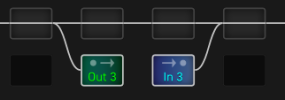This is incorrect. The screenshot is showing it wired in series. Removing the shunt between Out3 and In3 would change the behavior such that when In3 is bypassed no signal would hit the wah block.Is the Freqout supposed to be in parallel with the signal or in series? This wiring has it in parallel. If you want it in series, you will want to get rid of the connection between out3 and in 3.

So to clarify, I should set input 3 settings to sum and switch the loop to be in parallel? Everything works as I have it now, what’s the advantage or reason for these changes? Just to go better understand, thank youThat's correct. With Copy L>R you can connect the FreqOut to either the L or R output 3. If you want similar behavior on Input3, set its input mode to Sum L+R.
This is incorrect. The screenshot is showing it wired in series. Removing the shunt between Out3 and In3 would change the behavior such that when In3 is bypassed no signal would hit the wah block.
Here's how to run the loop in parallel:
View attachment 128566

It will work either way but I would keep the grid the way you have it so it's running in series. It's modifying the dry guitar sound, like a distortion or tremolo, so I'd run it in series.So to clarify, I should set input 3 settings to sum and switch the loop to be in parallel? Everything works as I have it now, what’s the advantage or reason for these changes? Just to go better understand, thank you
Got it! I just tried it and noticed how it felt odd in parallel with the dry signal still passing. Thanks for clarifying brother.It will work either way but I would keep the grid the way you have it so it's running in series. It's modifying the dry guitar sound, like a distortion or tremolo, so I'd run it in series.
Running an effect in parallel allows the dry to not leave the unit and then the output of whatever is in the loop is mixed back into the dry. The most common use for parallel effects are delays and reverbs. In general they don't modify the dry, they simply mix their tails in with the dry. So you could set a reverb to 100% wet, put it in parallel, and then the output level of the reverb block would control how much of the reverb sound is mixed back in with the dry.
Since you're familar with DAW operation, running an effect in parallel is like adding a bus send to a track. The bus has a 100% wet reverb, you're sending a certain amount of the dry signal into the reverb, and the reverb signal (with no dry) is mixed in at the main outputs.
I’ll double check this later. I think I remember feeling like I was only hearing the feedback in one side when I had the input set that way.Output 3 Mode: doesn't matter in this example as the signal would be mono at that point.
Input 3 mode: Use Left Only or Right Only, whichever In 3 jack you're connected to. Since the Freqout is mono out, Sum L+R would just add noise from the unused In 3 jack.
Out 3 Boost/Pad: Setting this as high as possible without clipping Out 3 should give the lowest noise floor (see manual).
You'll probably want to keep the series loop routing. The Freqout isn't really designed for parallel use since it handles the fading between dry & fake feedback tones, and an extra dry path in the grid would create phase issues.
